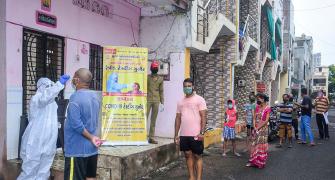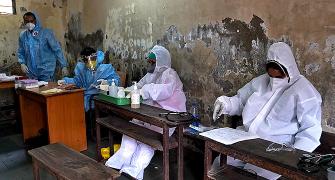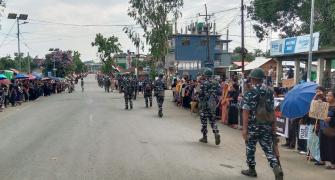'Every disease has traits and we have found out that actually 99 per cent of people who have got COVID-19, should recover.'

Heart surgeon Dr Sanjeeth Peter, who has been operating for 25 years, is the director and chief cardiac surgeon at the DDMM Heart Institute, a super specialty hospital, in the small town of Nadiad, southeast Gujarat, about 60 km from Ahmedabad.
Dr Peter, as a critical care team member for COVID-19 patient care in Gujarat, offers his logical analysis and perspective on India's COVID-19 situation.
In Part 2 of this interview to Vaihayasi Pande Daniel/Rediff.com, Dr Peter talks about the prevalence of the virus and the gold standard of testing.
Why the spread of COVID-19 will differ from region to region:
The prevalence will differ in a specific geographical area from another geographical area.
If you look at the prevalence in the area of a person who has been infected with COVID-19, let's say in Mumbai, it will be, I'm sure, be very, very different from the prevalence in the area of a person, who has been infected in Tezpur, in Assam, or maybe Arunachal Pradesh.
It would be very different.
I think we need to look at geographical areas, rather than looking at India as a whole, when we talk about the numbers.

Intelligent Monitoring Analysis Services Quarantine (iMASQ), the testing facilities, are housed in specially designed buses, developed by Hyderabad-based Vera Smart Healthcare. August 9, 2020. Photograph: PTI Photo
You say this in reference to the COVID-19 cases peaking situation.
Are you talking about the actual case numbers?
Even the actual cases.
Remember it will go there (another geographical area) and start replicating in that community.
The numbers will increase in that community slightly differently from the way it would (elsewhere), because of the local geographical patterns.
Like for example, in a crowded place: If people are not following the three (COVID-19 rules) of physical distancing (I'd like to call it physical, not social), second, wearing a mask and the third if they don't follow simple hand etiquette, the chances of replication or the chances of the spread is going to be much higher.
Much higher than say a village, or a predominantly rural area, where anyway the distance between the huts will be quite far.
They're not spending a lot of time with each other, things like that.
It's bound to be different.
It is best to look at geographical area, and then understand what the situation is in that particular area, according to the local conditions.

More about how many infected versus how many recovered and recovery rate:
(About) your question on how many infected therefore how many healed, you must count every one of these people - both infected currently, and who have ever been infected as cases. That is the total cases.
You are hundred percent correct when you say we will never know the actual cases unless we test.
Any statistic which is trying to tell you the rate -- whether it is recovery rate or whether it is mortality rate or whether it is infection rate -- it all has a numerator and denominator, because it is a rate after all.
And only if both the numerator and denominator are accurate will you be able to get an accurate rate.
Now let's look at recovery rate:
As I said, we expect that 99 per cent are going to recover and at the end of the pandemic we had better have that 99 per cent recovery rate, because that's the way this virus is behaving.
This virus has some traits, which, I keep emphasising, are traits peculiar to it.
Every disease has traits peculiar to it.
We all have traits which are peculiar to ourselves.
I will give an example of a leopard: A leopard has a trait of taking its prey - whatever it has killed -- up a tree to eat it.
It doesn't sit on the side of the road and eat.
Whereas a dog will sit on the side of the road and eat it.
If you are looking for a leopard and you start going to the side of the road, you're not gonna find it. It is still going to be on the top of a tree.
Every disease has traits and we have found that actually 99 per cent of people who get COVID-19, recover.
So, if you're telling me that our recovery rate is 60 per cent, that's not the entire picture.
We have to have a 99 per cent recovery.
I do understand that the authorities want to instill confidence among people.
But let's realise that it is still going to be 99 per cent (recovery rate) at the end of this pandemic.
Also, if you're looking at recovery rate again, it is the number of persons who have recovered, over (divided by) the number of persons who have got the illness.

And we don't know the denominator.
Yes! We don't know the denominator.
Secondly, it should be at a point in time and taking the average number of days that the person has taken to recover.
So, let's say -- I'm just giving you an example - till the 5th of July, we had 100 cases, who have been infected.
If you want to see the (actual and correct) recovery rate of those same 100, you should check on the 26th of July, which is three weeks later, to see how many of those same 100 have recovered.
And you will find that it is 99 per cent.
What we're doing instead is we are taking the total number of those infected today and the total number of people who have been declared as cured today (and doing the math for a recovery rate).
You can't do that.
You should follow up the same set of people, who have been infected, and then see when they recovered and how many of those recovered.
That would be the correct recovery rate.
Therefore, you get the recovery rate only after this (period of) time.

But why is this correct kind of calculation - as you have just explained -- not happening?
Is it not happening because the ICMR is not suggesting that it be done this way.
Or the government is not suggesting?
Why?
No, no, it's happening because you can't follow up those exact patients, because it is a huge data.
I mean you are looking at 7 lakhs or 7.5 lakhs (the total number of cases in India today).
And then you have to see how many of those 7.5 lakhs were actually infected before, for example July 5. We then need to check on those same set of patients, and find out how many are now healed.
That's the way you should look at it.
But they are looking at the overall picture and trying to instil confidence in the public.

Is this basically happening because this is a chaotic situation?
And everyone's trying to make the best of a chaotic situation by posting this kind of data to assure people?
Yes.
I think in a way people are getting assured, so that's a good thing.
But if they do it in this way (ie the right) way, they would be even more assured.
The public would be even more assured that: 'Yes, oh well 99 per cent are recovering'. That's the way to look at it.
That, I think, answers your question on recovery rate and what those statistics are all about.

Deployed in interior, inaccessible, parts of the country it has the capability to perform 25 RT-PCR tests/day, 300 ELISA tests/day and additional testts for TB, HIV , June 18, 2020. Photograph: ANI Photo
What about the numbers we are issuing about how many in India had COVID-19, when widespread testing and tracking is not possible it seems?
On how many really have it and what is our number -- you're right.
How will we know those numbers?
Only if we test.
And we know that they aren't.
The gold standard test that we're using currently today is called the RT- PCR test**.
If you look at the RT-PCR itself, a single RT-PCR test has a sensitivity of a maximum of 70 per cent.
That means 30 per cent of those RT-PCRs will also cover false negatives.
We need to test, we need to do more of testing, we need to do double and triple the amount of testing (than we are currently doing).
But I think we are spending a lot of money on that, with very little returns. Why are we doing that?
Why do we want to do RT-PCR testing?
Fine, you do RT-PCR testing in select areas.
But don't think that's going to really give you a clear or true picture of the number of cases that we have in India.
It's much more than that.
It is obviously spreading in India and to several geographical areas as well.
Therefore, just looking at those numbers, and the RT-PCR positives and saying that that's all the numbers that we have -- is not correct.
We obviously have many more cases than that.
Why are we doing this.
We are doing this to identify and then probably isolate that particular area.
But remember that even if you isolate that particular family or that area or the repeated contacts, there are several others who have missed the RT- PCR testing because of a false negative or we have not really checked that entire area.
So therefore, you can't net in everybody.
There will be people who will slip out of that net.
So RT-PCRs, per se, give you a rough idea as to how many people are infected.
And it's a good thing, because at least now people have realised that it is much more widespread than what it was thought to be and that it is spreading in areas (they had not known about).
People also know, that because of our large population, we probably will, at the end of the pandemic, have the highest number of cases in the world.
Again, when I say cases, people who have ever had COVID-19.
It could be active cases.
It could be healed cases.
But cases nonetheless, and they ought to be counted in that.

But when you're talking about this test, which has a 30 per cent chance of being false, are you suggesting that they use some other test as well?
Or that's just how it is?
There is no other test.
This is the gold standard.
There is another test called NAT***.
There also there is only 60 per cent accuracy.
You still will have 30 to 40 per cent people slipping out of the net.
Unfortunately, that's (RT-PCR) the best test that we have.

On the reasons for the low sensitivity of the RT-PCR test:
The reason why I give this sensitivity of 30 to 70 per cent is because it depends on five things.
Number one, it depends on where the swab was taken from.
If the swab has been taken from the back of the throat, whether it was taken from the saliva, or whether it was taken from the back of the nose (etc).
Secondly, it will depend on what time in the illness it was taken.
(Probability of the test being positive) is highest on Day 3 or Day 4, whereas if you take it on Day 1 or maybe Day 10, it may not be positive.
Third, it depends on who has taken it.
There are trained people.
Or you might have a person for whom, maybe, it is the third time he's taking a test -- compared to someone who has done it a thousand times -- obviously the experience matters there.
Fourth, it depends on the transport.
And, for example, how has the sample been transported from the point where it was taken to the point where the test is actually going to be done.
Fifth, it will also depend on the time difference between the when the sample is collected and when the test was actually done.
So, all of these variables put together give us a sensitivity of between 40 and 70 per cent.
But we must remember people will still slip out of that net or will still get false negatives, because of the inherent nature of that test.
There's a reason to test even more, because of that?
Yes. Absolutely.
That is if you want to follow the identify and isolate the people who are the contacts (route).
But yes, that's the way to go.
**an expensive test that uses a lab technology called real-time reverse transcription polymerase chain reaction that amplifies the genetic fragments of the virus so there is enough to test.
***Nucleic Acid Test which detects the SARS-CoV-2 E-gene and results can be made available in half an hour.
Feature Presentation: Ashish Narsale/Rediff.com











